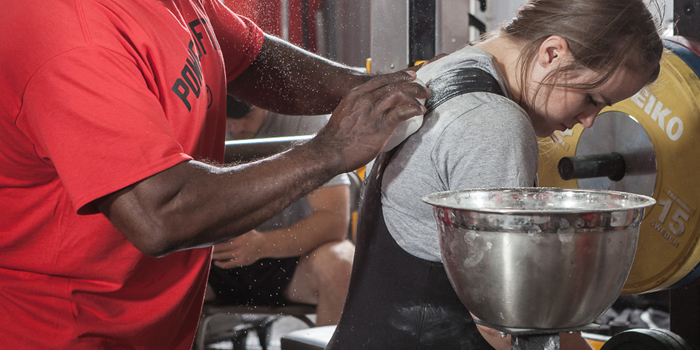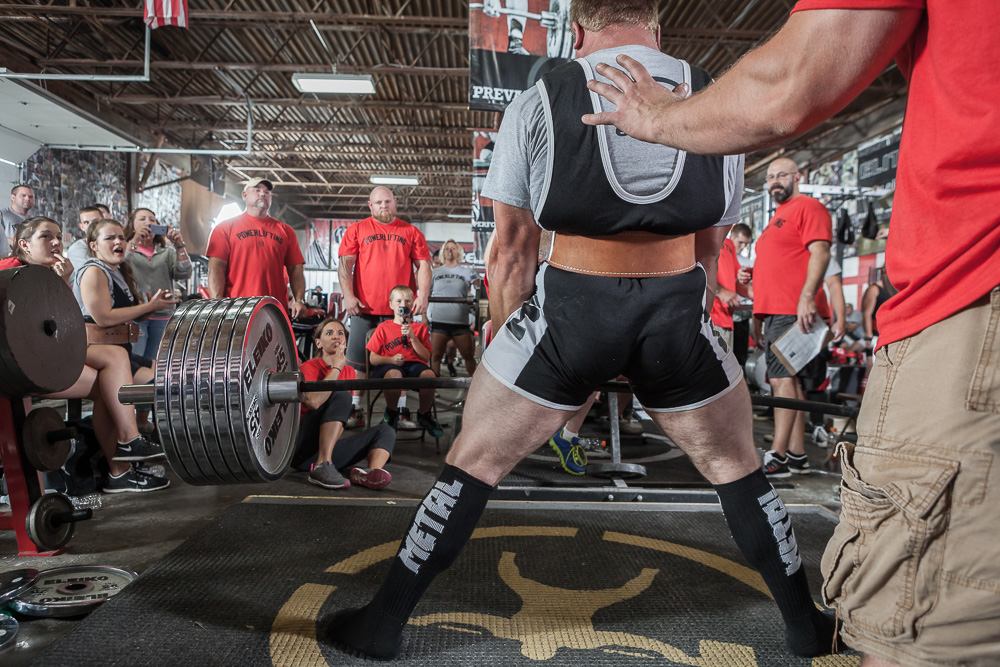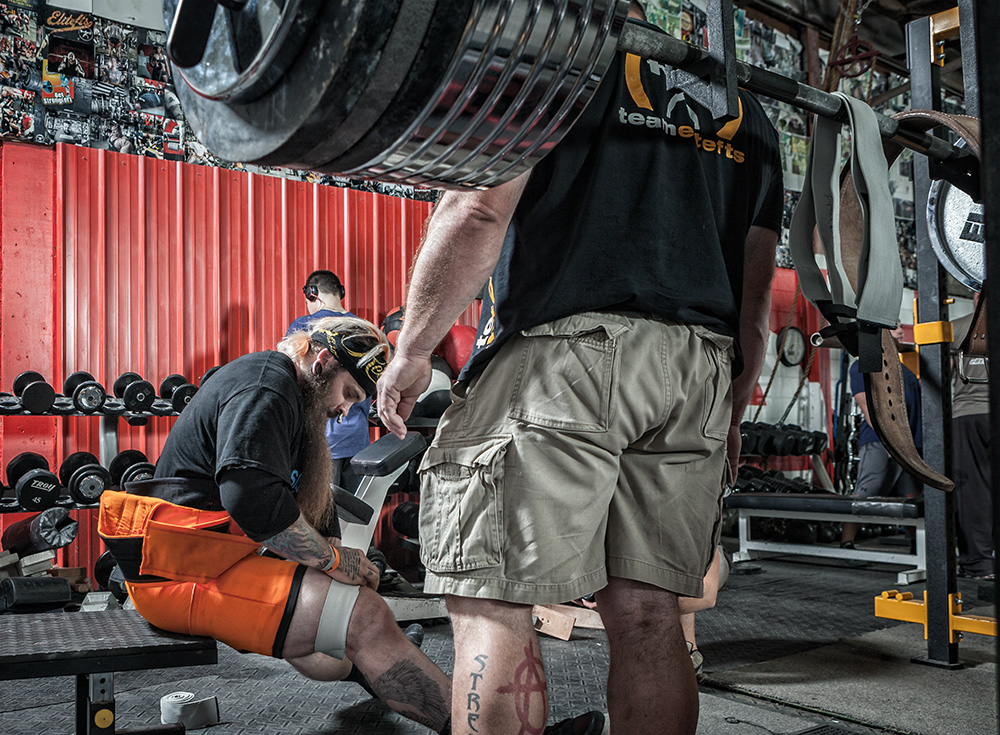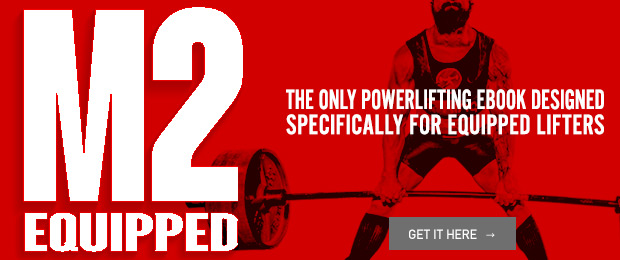
Being one of the few elitefts lifters who has competed raw, single-ply, and multi-ply, I’ve had the ability to try a variety of gear to determine what I feel works best.
Let’s start with the basics:
Squat Shoes — If you’re a raw, quad-dominant squatter then you’ll want shoes with a heel (such a as a weightlifting shoe) to help shift your weight onto your quads. If you’re a hamstring and glute dominant squatter you’ll want a flat soled shoe such as the Metal Powerlifting Shoes, Converse Chuck Taylor, wrestling, or Otomix. I now use Jordan boxing shoes (which they unfortunately don’t make anymore), but would opt for the Metal or Otomix over the others since I prefer to have more ankle support than the Chucks provide. Since the combination of the hamstrings and glutes is a larger (and thus stronger) group of muscles than the quadriceps, I’d recommend for all lifters to try to use flat soled shoes of some sort.
Bench Shoes — Since you’ll want to focus on driving your heels to the floor as you press (regardless of whether you are flat footed or on the balls of your feet) you’ll want to use a regular tennis or cross training shoe that has good traction and a heel to force into the floor if your feet are flat.
Deadlift Shoes — As with the squat, you’ll want a flat soled shoe so that you can shift the weight onto your heels thus better recruiting your hamstrings and glutes. Wrestling shoes are ideal since they are flat soled, not elevated, and still provide adequate ankle support.
Squat and Deadlift Belt — For the squat and deadlift you’ll want a power belt that is of even height and width throughout. This purpose of a power belt isn’t just to support your lower back but to increase abdominal pressure by pressing your belly against it in order to keep your entire midsection tight. I prefer to use a lever belt due to the ease of adjustment.
Bench Belt — If a belt is worn for the bench it should be of the least material possible in order to hold the bench shirt in place (if one is being worn) without inhibiting the arch.
Singlet — The main point of a singlet is so that judges in a meet can see that the crease of your hip is below the top of your knee for the squat and that your butt remains on the bench for the bench press. Still, lifters seek to get some carryover through their use. I have to admit that in raw meets I’ve worn a small singlet to squat and deadlift and an XL to bench. Metal is working on designing a more supportive one, so it’s worth a shot.
Knee Wraps — The Metal All Black knee wraps are by far the best knee wraps I’ve ever used. They’re the ideal combination of comfort, elasticity, and support.
If you’re just looking to start training in gear in order to handle heavier weights and prevent injury, I’d recommend starting with a pair of Pro or Ace briefs to squat and deadlift and either a looser single-ply Metal Bash shirt to bench or a Slingshot. From that point I’d recommend training in the kind of gear that you plan to compete in. So, if you plan to compete in multi-ply then go ahead and start training in it. There’s no point in wasting your time in training in something different and then having to adapt once again when you switch to what you’ll actually be competing in.
RECENT: Reliving the Powerlifting Glory Days: My Best Meets of '05–'08
Single-Ply
Squat — For IPF lifters I would recommend the IPF King Squatter. For any other feds I’d recommend the Metal “M” squat suit since the seams are reinforced to provide additional support.
Bench — For IPF lifters I would recommend the Metal IPF King Presser. The sleeve angle is easy to adapt to and the sleeves are pre-twisted to assist with the lockout. For any other fed I’d recommend the Bash. You’ll have to add a stretchy back if the fed you’re competing in requires one, but you can buy material at a fabric store and have any local seamstress add it on. The Bash material is comfortable while still being extremely supportive.
Deadlift — For any fed or stance (sumo or conventional) the Metal King suit is the way to go. The material is supportive while still allowing enough give to get to the bar in a good starting position.
Multi-Ply
Briefs — Depending on how much support you’re seeking or how much space you’re looking to fill underneath your suit, the Pro or Ace is the way to go. This material is ideal for support and comfort as well as having a cut to support a wider stance.
Squat — Ace or Jack with Jack or Ace briefs. If you have trouble hitting depth, I’d recommend the Jack suit. It has great rebound and support while still allowing for enough give to hit depth more easily. The Ace brief/Jack suit combo is ideal for this purpose. If you’re looking for the most support and carryover possible, the Ace-on-Ace combo is the way to go. Both the Ace and Jack suits have Velcro straps that can be adjusted for progressively heavier attempts. Now that the canvas is available, if you’re an upright, wide stance squatter that uses a high bar placement, then the canvas is going to be the must supportive suit available.
Bench — Although I’m known for benching in denim, times have changed and denim isn’t used much if at all anymore. However, Ginny Phillips still makes custom made double denim shirts. As far as the Metal shirts go, the Ace bench shirt has the ideal amount of support with a forgiving enough groove to touch with less chance of getting out of the groove. Much of the support from any shirt comes from the collar. The Ace shirt has an open back with a very supportive collar than can be adjusted lower for heavier attempts.
Deadlift — The Pro King is ideal since it has Velcro straps so it’s easy to adjust for heavier attempts. It’s also double-ply in the back and single-ply in the back making it easier to get to the bar and stay upright.
Regardless of what gear you opt for, it all takes time to learn and master. Don’t make the mistake of repeatedly trying to use different gear to get more carryover. In order to improve and get the most carryover, everything requires patience and determination.













4 Comments